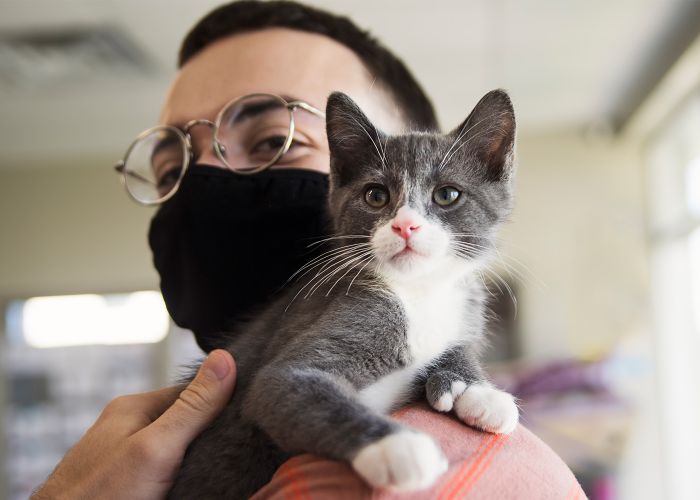Can you hear me meow?
Trade the silent treatment for rapid response

Has your rescue ever been so overwhelmed with phone calls and emails that someone threatened to sue? Not yet? Then despite your overflowing voicemail box and unspeakable unread email count, your organization is likely in better shape, customer service-wise, than Black Dog Animal Rescue in Cheyenne, Wyoming, was in 2012.
Founder Britney Wallesch was working full time while single-handedly running the foster-based organization. After the rescue failed to respond to calls and emails during work hours, a few community members got “very, very angry all at the same time,” she says, and one person even threatened to take the organization to court. “We live in a small town, so they were talking all over town about what a ‘terrible’ organization we were.”
Whether or not those particular residents were being fair to Black Dog (or had grounds to sue), “the demands of the organization were starting to exceed my capability as a single person,” Wallesch says. Even though the rescue relied on a network of around 70 volunteers, “I didn’t have any extra time to devote to training volunteers to help, because when I spent my time doing that, things like phone and email would pile up.”
The community “just felt like they were trying to support us and they were trying to do the right thing by adopting a pet, and we were making that difficult for them to do,” she says.
Anne Fifield, a co-founder of Bassett Rescue Across Texas (BRAT) in the Dallas area, has seen the problem before. In her first rescue position, the founder “did almost everything, so she didn’t know what to hand off or how to hand it off,” she says. “I thought, ‘Well, this is crazy, we have all these volunteer applications!’”
Calls and emails are just the tip of the iceberg, says Fifield. If your organization is unable to respond to communications in a professional and timely way, you’re likely falling short in other areas, as well, like properly delegating tasks among volunteers and maximizing your rescue’s efficiency.
“Animal sheltering is a customer service business,” adds Wallesch. Your inboxes and outboxes might seem like the least important aspect of running a rescue—after all, there are dogs to rehabilitate or kittens to bottle-feed—but your communications are customer-facing. Losing track of adoption and volunteer applications, accidentally deleting voicemails and never responding to emails means your “customers” are likely to feel spurned—and likely to adopt, donate, volunteer and point others elsewhere.
It’s a thin (phone) line between love and hate
It may initially feel wonderful when your community is so involved that it inundates your rescue with calls, emails, Facebook posts, Tweets or direct messages through social media. But when your rescue isn’t equipped to handle the volume of those communications, it can start to feel less exciting and more … scary. To get a handle on that mess of messages, you need to devise internal policies for responding to communications and a system for allocating the workload.
Black Dog uses a single cell phone line. It used to go straight to voicemail, but “people were just grossly dissatisfied with that,” says Wallesch. Even after she quit her job to work full time for the rescue (initially paying herself for just 15 hours a week while working 40 to 60), hired two paid staffers and implemented a policy of responding to voicemails within 24 hours, Black Dog’s constituents reiterated that dissatisfaction in a 2014 survey.
“The public does not care that you’re all-volunteer or you only have two staff members; they care who responds to them the fastest because they want to adopt a pet,” says Wallesch. “The perception is that the person who answers the phone is the one who cares about them the most.”
Now, Black Dog’s policy is that anyone in the main office has a responsibility to answer the phone—“If the phone is ringing, somebody’s going to answer it,” she says—and staff and volunteers must check their email at least three times a day. The rescue receives around 40 calls a day and processes around 120 adoption applications a month, mostly via email. Busy staffers “control the conversation” by keeping complicated calls short and letting people know they’ll receive a follow-up call or email at a later time.
“That’s taken away some of the fear and anxiety of answering the phone because you don’t know how much time it’s going to take,” says Wallesch. “You have to answer the phone, but you can still be busy.” It’s also important to incorporate basic customer service training into your volunteer orientation and have conversations with staffers about your organization’s expectations for “transparent, receptive and open” communications with the public, she says, including how to see “not so nice” messages as opportunities to make a connection.
In general, staffers keep communications manageable by disabling direct messaging on social media and restricting weekend emails to an auto-response detailing the rescue’s hours and answers to standard questions; in case of emergencies, fosters can dial an emergency line, free via Google Voice, that calls all staffers at the same time. After hours on weekdays, a voicemail message advises people that all calls will be returned during business hours. On weekends, calls may be forwarded to a rotating staffer’s personal phone, who dials star-67 before calling back to maintain privacy, or rotating volunteers may call into the organization’s voicemail box and return messages left there.
Staffers and volunteers often hear from adopters that Black Dog was the “only” rescue to respond to a call or email. “People are willing to wait to adopt from a rescue [even] if the process takes longer … but you have to communicate with them,” says Wallesch. “Then they’re happy to wait because they know what they’re waiting for.”

Getting all your dogs in a row
In recent years, there’s been a boom in inexpensive and customizable constituent relationship management (CRM) software, and more nonprofits are using these online systems to track communications with adopters, donors, volunteers and other constituents. But smaller nonprofits might find that simpler programs, along with solid communications protocols, are best suited to their resources and needs.
If you’re having trouble juggling voicemail and email, inexpensive voicemail-to-email services can automatically send each voicemail message as an audio file to your organization’s email inbox, allowing volunteers and staff to keep these communications in one place. Such services might also include multiple voicemail boxes with the capability to record long voicemail messages detailing your organization’s hours, mission and services—a helpful blockade that could ensure your trap-neuter-return organization finds itself fielding fewer calls about surrendering pets.
In Texas, Fifield works with around 50 volunteers to manage roughly 30-50 emails a day and up to 50 adoption applications a week. The rescue uses an integrated communications system, including data management, online forms, voicemail and email accounts, from RescueGroups.org, a nonprofit that provides technology services to over 5,600 animal welfare organizations.
People running shelters and rescues “are primarily animal people,” who generally don’t have the technical expertise to optimize data management and communications, says RescueGroups.org co-founder Richard Saffell. After the founders volunteered their technical services at a rescue in 2002, “we realized that what we were doing for them could really benefit shelters and rescues across the country. … [The services are] primarily focused on helping organizations to work more effectively—to improve their communications, to organize their information, their data, their fosters, their contacts, their animals.”
BRAT volunteers are divided into committees—such as fostering, adoptions, volunteer management, administration and social media committees—and assigned tasks based on their experience and available hours. Fifield keeps a running list of volunteer assignments and occasionally mixes up their tasks to avoid burnout; volunteers use this list to divvy up calls and emails among specific people.
Calls to the rescue always go straight to voicemail, but BRAT’s voicemail-to-email service sends those messages to the organization’s email inbox. Four volunteers take on inbox duty at specified times throughout the day—such as 6 a.m. to noon or noon to 4 p.m.—and forward those emails to the appropriate person for follow-up within an hour. “Voicemail really takes precedence,” Fifield says.
At her previous rescues, “we would have to send emails to all the volunteers to [keep] us all in the loop, and of course someone was left out of the email, or someone did something that someone had already done, and it was so chaotic and hard to keep up with,” Fifield says.
Volunteers also use the group’s data management and online forms systems to track adoption applications, allowing volunteers to mark application status (submitted, pending), add notes (“called applicant three times; no response”) and keep emails to and from the applicant all in one place. When a volunteer responds to an application, the system keeps a copy of that email alongside the application. Generally, that same volunteer then works with the applicant throughout the process, handling all communications and continuously updating application notes.
“When I first started with that first rescue, it was just one person who knew it all. ‘What’s going on with this dog? We’ll call Sam. What’s going on with this application? We’ll call Sam,’ and poor Sam was worked to death,” says Fifield. “If I’m in the hospital, [anyone] can go into the website and look. They don’t even need me!”
Fifield previously implemented similar organizational systems at two other rescues, both of which still use the systems today. “If you don’t have the work environment where you can all work efficiently, it just gets so confusing,” she says. Without organized communications, “I would be pulling my hair out.”








